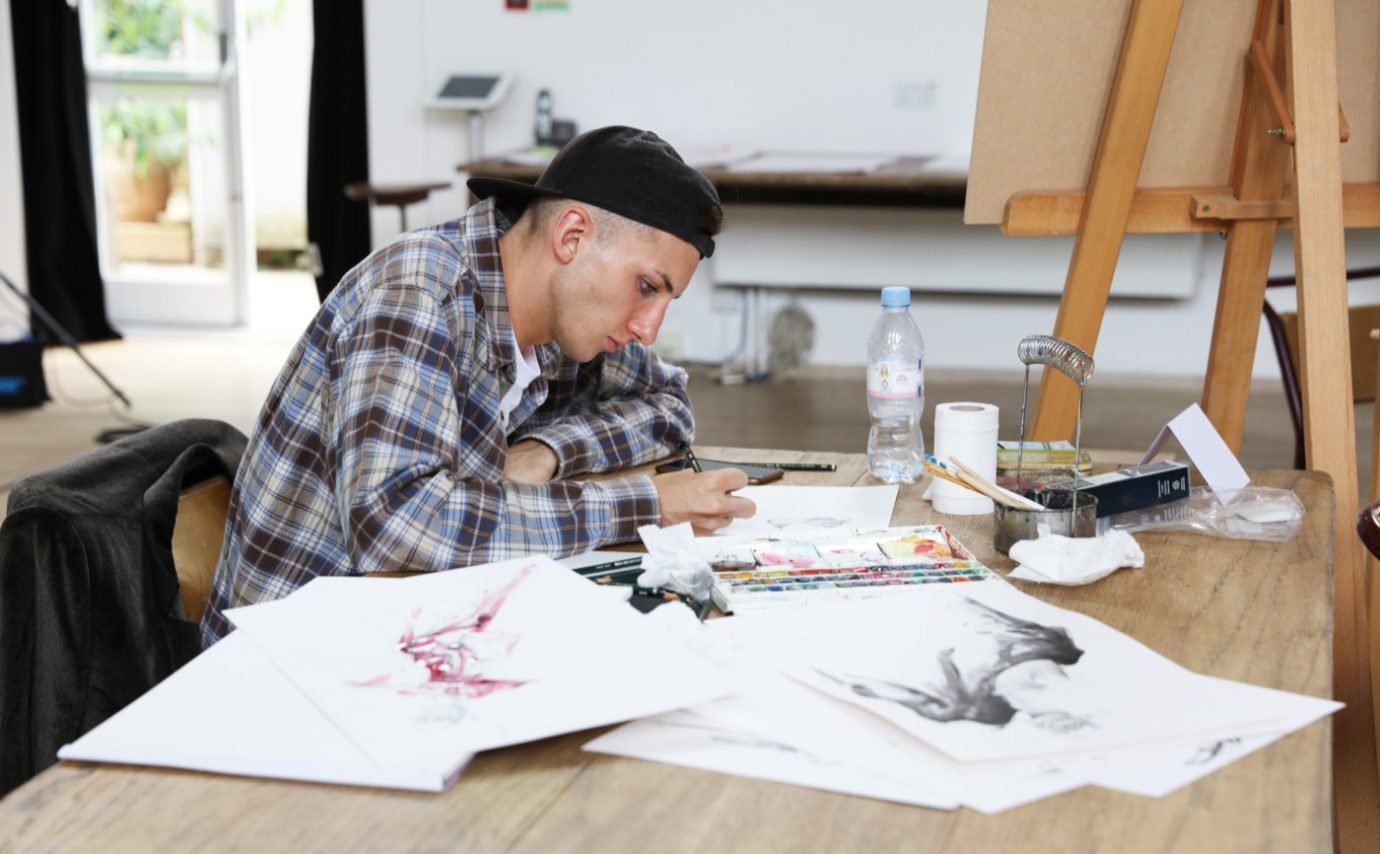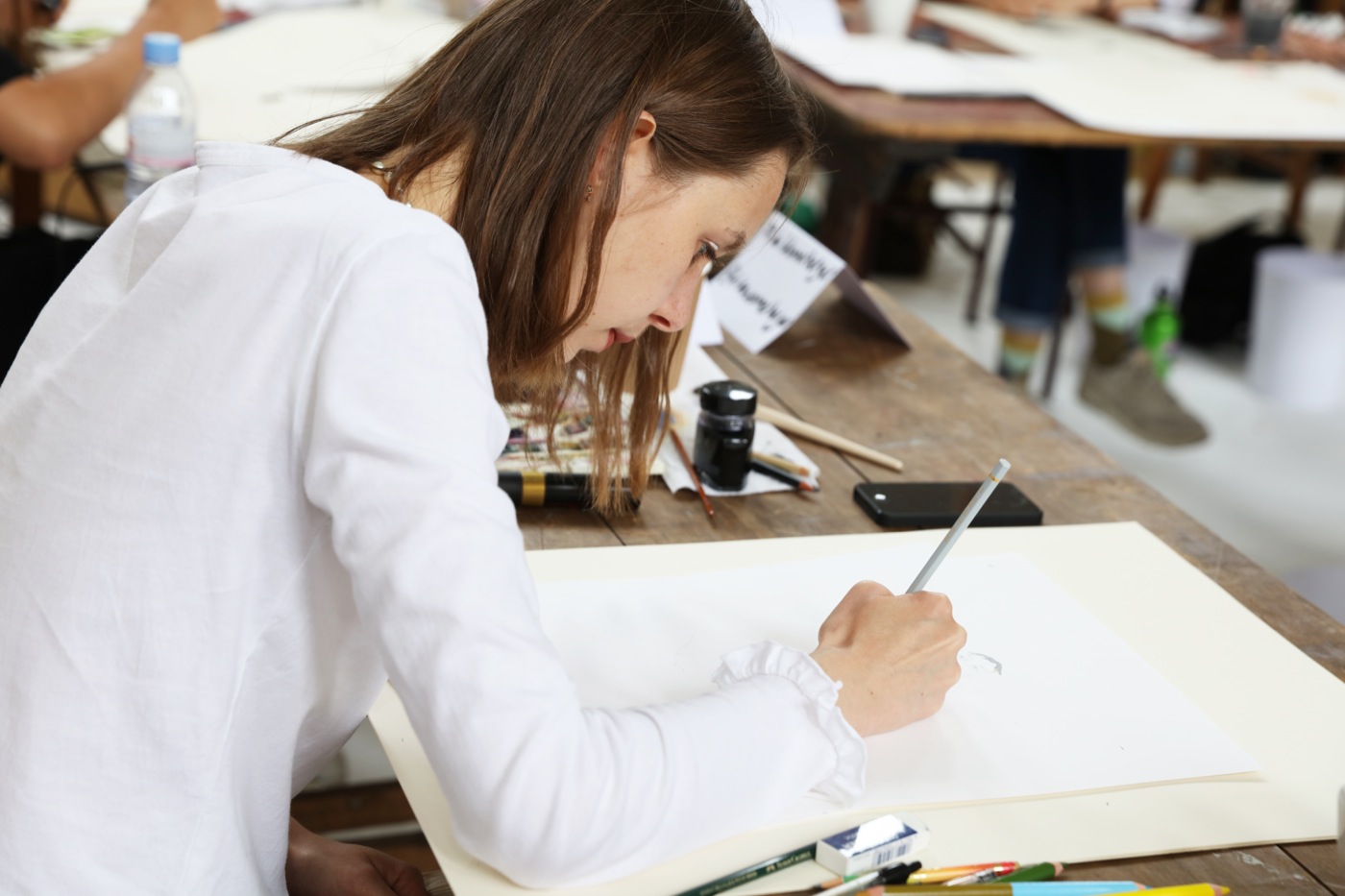How is social media changing the way that illustrators work? What does it take to turn it into a full-time profession when money in the creative industry is scarce, and is being in the same country as the client vital? Three up-and-coming illustrators who graduated from Central Saint Martins dig into the conversation: Richard Kilroy, Helen Bullock and Frida Wannerberger. Together with 17 other bright talents, they gathered at SHOWstudio last week for a very special live drawing class — which at the same time functioned as a shoot for Garage Magazine with photographer Nick Knight and stylist Charlotte Stockdale. We had the chance to catch up and get good advice for emerging artists keen to take their work to the next level.
“I’M FINDING THAT SO MANY PEOPLE SEEM TO SPEAK, IN A WAY, ABOUT POSTING AS IF YOU OWE YOUR ‘AUDIENCE’ SOMETHING, AS OPPOSED TO DOING WORK FOR YOUR OWN BENEFIT. I’M NOT GOING TO DO FILLER POSTS TO STAY IN SIGHT.”
In what ways does having your illustration work accessible to a wide online audience impact your work?
I think the success of Instagram and the nature of it, has definitely made everyone more savvy with uploading what they do and keeping themselves visible. I’ve been on somewhat of a sabbatical these last few months and I’m constantly aware of ‘the lack of posts’. I’m finding that so many people seem to speak, in a way, about posting as if you owe your ‘audience’ something, as opposed to doing work for your own benefit. I’m not going to do filler posts to stay in sight.
The mentality of ‘likes’ is something that for some is definitely going to plague the deliberation of posting work. It’s natural to question the amount of likes on a post, but this shouldn’t define it in terms of taste or validation. It’s becoming almost commonplace to commodify these numbers as definitive, when an element of it can be arbitrary. ‘Greatest amount of likes’ doesn’t always mean greatest piece of work. Some of my favourite works received the least amount of likes and I don’t let it worry me.
Are you represented by an agency?
Ha, no, I don’t think any agencies would want me! I can make decent to good money out of some jobs, but I’m quite singular in my focus, which is menswear and male subjects. Agencies want illustrators who can apply their style to as many variables as possible, which I totally get. I probably should expand a little more, but I’m very obsessed with figurative work. I’ve turned down several jobs lately where the money was good, but the brief made me want to just curl up and die.
How long did it take you to become a full-time illustrator?
I’ve never been a full-time illustrator. I don’t know many who have, a small handful, most very established. It can quite often be a double life, whether it is alongside a relatable part-time job or tutoring, which I’ve been doing the last few years and enjoy doing.
If you have clients abroad, how important is it to be in the same city as them?
I haven’t had a great deal from abroad, but it always helps to meet a client in person and put a face and a personality to their name; to become more personal with them. Work can go ahead and be done all the same through email, text and over the phone. It isn’t absolutely crucial, but I believe in the luxury of being in a city where so many people are accessible to each other. There is a lot to be said for the environment and social circles you wind up in when working in fashion; conversations and introductions to friends and colleagues, they lead into new ideas and plans. They might move to a different country and spread good word. I just prefer getting a natural feel for people and navigate my way.
Helen Bullock
“I HAVE A LOT OF PASSION FOR THIS INDUSTRY AND ALTHOUGH IT CAN BE TOUGH, WHENEVER I FEEL A LITTLE DOUBTFUL OF MY CHOICES, I REALISE THE ALTERNATIVES ARE ABSOLUTELY NOT FOR ME.”
In what ways does having your illustration work accessible to a wide online audience inform your work?
I try not to think too much about who’s viewing my work, in terms of the actual outcome. However, I definitely have the underlying hope that it will cross oceans to potential exciting new clients and friends.
Are you represented by an agency?
No… but I’m currently searching. Offers welcome!
How long did it take you to become a full-time illustrator, and how did you get there?
I wouldn’t say I’m really full time — I also work as a textile designer and lecturer. I got to this position by persistence and hard work! I have a lot of passion for this industry and although it can be tough, whenever I feel a little doubtful of my choices, I realise the alternatives are absolutely not for me.
If you have clients abroad, how important is it to be in the same city as them?
Due to technology — unless the project really requires you to be in the same room — you can manage very easily to work from different locations. However, I relish the opportunity to travel and have direct contact with the project.
Frida Wannerberger
“THE WORK THAT I’M THE MOST EXCITED ABOUT IS GENERALLY WHAT SEEMS TO GET THE MOST INTERACTION TOO, SO THAT’S A GOOD GUIDELINE.”
In what ways does having your illustration work accessible to a wide online audience impact your work?
It changes the way I want to produce work. The more other people can see the work, the more I can see it too. I’m constantly very aware of how the work looks. That in itself is fine, but when you start wanting to combine quantity and quality, there usually is a problem… The work that I’m the most excited about is generally what seems to get the most interaction too, so that’s a good guideline.
Are you represented by an agency?
Yes, callmyagent.fr, since about a year.
How long did it take you to become a full-time illustrator, and how did you get there?
Now, in my third year after graduating, I can just about turn down regular part-time work for commissions. As with creative businesses today: loads of opportunities, but little money. Be yourself and know what you want to do. Go for the projects, people, companies that you like and admire. Do really good work, present it really well, have a voice and find your fit!












